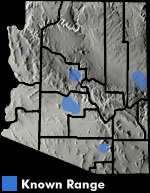Online Field Guide to The Reptiles and Amphibians of Arizona



Captive
| PAINTED TURTLE Chrysemys picta | |
| DESCRIPTION: A medium-sized (shell up to 250 mm or 10″ in length) aquatic turtle with a low, smooth, dark olive, gray-brown, or black shell marked with yellow and red lines around the edges. The head and limbs are dark olive-gray with numerous cream and yellow stripes. A dark horizontal bar runs through the middle of each eye. The bottom part of the shell (plastron) is marked with a single large, dark, central blotch on a red or yellow background. The rear edge of the carapace is smooth. Females grow to a much larger size than males. The similar looking Pond Slider has a large red patch on each side of the head.
By Thomas C. Brennan Brennan, T. C., & A. T. Holycross. 2006. A Field Guide to Amphibians and Reptiles in Arizona. Arizona Game and Fish Department. Phoenix, AZ Brennan, T. C., & A. T. Holycross. 2005. A Field Guide to Amphibians and Reptiles of Maricopa County. Arizona Game and Fish Department. Phoenix, AZ Stebbins, R.C. 1951. Amphibians of Western North America. University of California Press, Berkeley, CA. Stebbins. 1985. Western Reptiles and Amphibians. Houghton Mifflin. New York, NY Stebbins, R.C. 2003. A Field Guide to Western Reptiles and Amphibians, Third Edition. Houghton Mifflin Company, Boston, MA. |
|
Visit Partners in Amphibian and Reptile Conservation:


HOME
Copyright © 2023, Arizona Game and Fish Department. All rights reserved.
If you make use of the textual contents of this site in reports, publications, etc. please cite and credit the author(s) and photographer(s). All photos on this website are copyrighted. However, those found in the species account section may be used for any noncommercial scientific, educational, or conservation purposes provided that photographs are not altered and continue to bear the copyright symbol and name of the photographer. Please contact the photographer regarding commercial use of copyrighted photographs.










